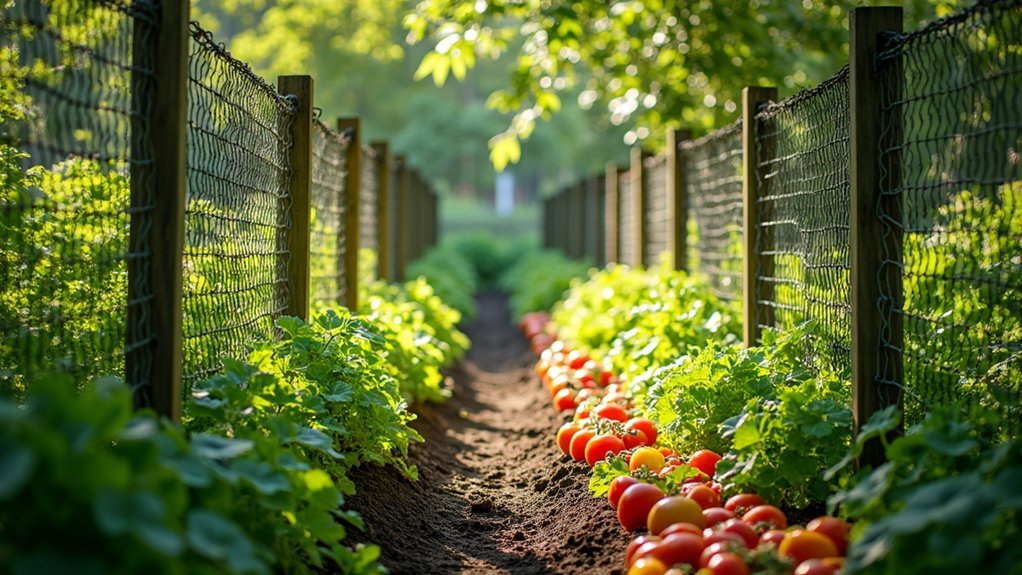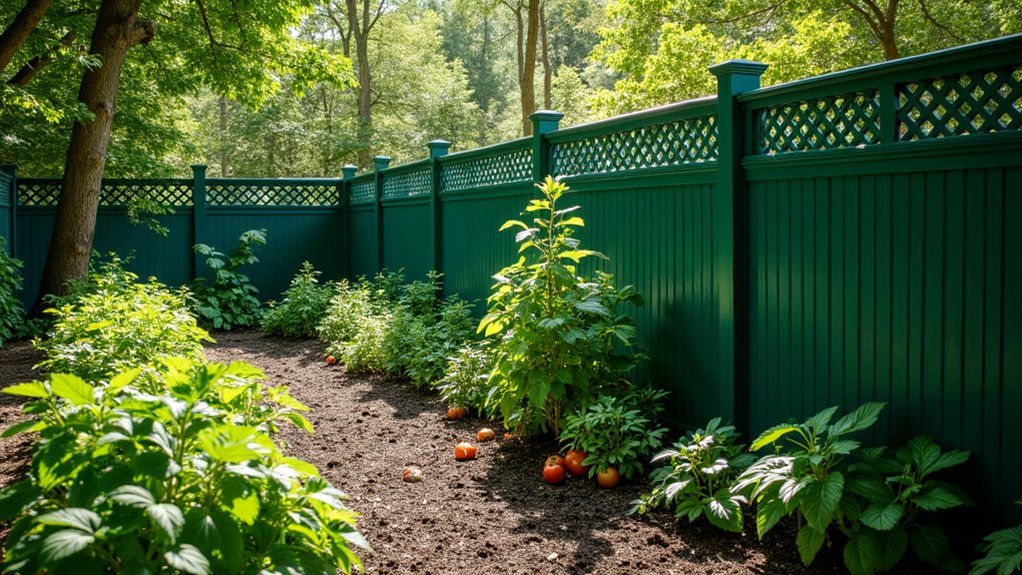To effectively deer-proof your veggie garden, install wire fencing at least 7 feet tall with a 2-foot chicken wire section at the bottom to block smaller critters. Add a taut white clothesline about 3 feet inside the fence as a psychological deterrent—deer won’t jump if they can’t see a clear landing zone. DIY installation costs around $750, considerably cheaper than professional options. The right combination of physical and mental barriers creates protection that lasts season after season.
Deer-Proof Fencing Solutions For Veggie Gardens

When deer set their sights on your prized vegetables, they’ll stop at almost nothing to feast on your garden bounty. To effectively protect your harvest, install wire fencing at least 7 feet tall—the minimum height needed to prevent these agile jumpers from clearing your barriers.
Choose a combination of welded wire with PVC coating for durability and visual appeal. For enhanced protection, add a two-foot chicken wire section at the bottom to keep rabbits and other small critters out.
A cost-effective psychological deterrent is placing a taut white clothesline three feet inside your deer fence perimeter. This simple addition creates confusion about landing zones, discouraging jumping altogether.
DIY installation costs average around $750 for materials—significantly lower than professional quotes that can exceed $10,000.
Understanding Deer Behavior and Garden Vulnerabilities
Although gardeners often underestimate deer intelligence, these resourceful animals possess remarkable problem-solving abilities and athletic prowess that make garden protection challenging.
Adult mule deer can clear seven-foot barriers with ease, requiring you to think strategically about keeping deer out of your precious garden spaces.
Underestimate a mule deer’s jumping ability at your garden’s peril—strategic barriers are essential for protecting your growing spaces.
When planning defenses, consider that deer carefully evaluate their landing zones before jumping. You can use this cautious nature to your advantage by creating psychological barriers that make deer hesitant to enter. They’ll naturally avoid situations where they perceive danger to their safety.
Your garden’s vulnerabilities—low fencing, readily accessible produce, and unprotected perimeters—act like dinner invitations to hungry deer.
To keep deer away effectively, install fencing at least four feet high, with additional barriers for smaller animals.
Traditional vs. Psychological Deer Barriers: What Works Best

While traditional deer fences rely on imposing 7-foot heights to physically block jumping, psychological barriers use deer’s natural instincts against unreasonable obstacles for effective protection.
You’ll find that installing professional wooden or wire fencing can cost upwards of $10,000, whereas a simple clothesline system might only set you back $20.
Your choice between these options ultimately depends on whether you prefer investing in physical barriers or leveraging deer psychology for a less visible but equally effective solution.
Height vs. Psychology
Why do homeowners continue spending thousands on towering fences when psychological barriers might work better?
Traditional wisdom suggests deer-proof fences must stand at least 7 feet tall, as adult mule deer easily clear lower barriers. This height requirement drives up costs, often exceeding $1,000 for professional installation.
Yet psychology offers a smarter approach. A simple system using two layers of wire and a taut clothesline positioned inside your fence creates an optical illusion that triggers deer’s self-preservation instincts.
These barriers have proven effective for four years straight with zero intrusions.
The most efficient solution combines moderate height with psychological deterrents like visibility-enhancing wire and strategically placed obstacles.
You can build an effective psychological barrier for as little as $20, saving hundreds while keeping your garden safe.
Cost-Benefit Analysis
When evaluating deer-proof fencing options, the bottom line often comes down to dollars and effectiveness. Traditional welded wire and electric garden fence solutions can cost between $1,049 and $3,679, while psychological barriers can keep deer away for just $20.
You’ll find the investment difference becomes even more significant over time. Traditional fencing often requires frequent repairs as deer damage the materials when attempting to jump over them.
Meanwhile, psychological barriers can remain effective for over eight years with minimal maintenance.
Consider that deer can jump up to seven feet, making traditional six-foot fences potentially ineffective without additional measures.
Cost-Effective DIY Fence Options for Small Gardens
Three practical DIY deer-proof fencing solutions can protect your small garden without breaking the bank. For around $20, you can construct an effective barrier using wire and a taut clothesline positioned 3 feet inside your perimeter. This psychological barrier makes deer perceive your garden as unsafe to enter.
A 4-foot fence works well against dogs and smaller pests, while heights of 5-7 feet prevent deer from jumping over. Combine welded wire or chicken wire with a 2-foot barrier at the bottom to block rabbits too. This thorough approach addresses multiple garden threats simultaneously.
These DIY options offer both durability and aesthetic appeal for small gardens, costing considerably less than professional installations that can run from $6,708 to $10,000 for larger areas.
Height Requirements for Effective Deer Deterrence

Understanding proper fence height constitutes the most critical factor in creating an effective deer barrier for your property. To truly keep the deer out, you’ll need to account for their impressive jumping abilities—adult mule deer can clear heights up to seven feet.
For open areas where deer have room to gain momentum, install fencing at least eight feet tall. In wooded or uneven terrain, seven-foot fencing typically provides sufficient protection.
If you’re enclosing a smaller garden (under 150 feet perimeter) or working with challenging terrain, you might get by with five to six-foot fencing, though determined deer may still breach these barriers.
Remember to space posts approximately ten feet apart to maintain structural integrity, and flag your new fence with white streamers during the first year to help deer recognize and avoid the barrier.
Materials Comparison: Wire, Wood, and Polymer Solutions
When weighing your deer-proof fencing options, you’ll need to balance the superior effectiveness of wire fencing against its higher upfront cost compared to wood or polymer alternatives.
Wood fencing offers aesthetic appeal but requires more maintenance, while polymer solutions provide a middle ground in both cost and durability.
Installation complexity varies greatly, with wire fencing typically requiring professional installation, wood demanding carpentry skills, and polymer options often coming in DIY-friendly kits that you can install yourself.
Effectiveness vs. Cost
Selecting the right fencing material for your deer-proof barrier involves balancing effectiveness against budget constraints.
When evaluating garden fence for deer options, wire fencing provides the best value proposition—typically costing around $750 for two heavy duty rolls while delivering superior long-term performance.
Wooden fencing, though visually appealing, comes with a steep price tag of $6,708-$10,000 for professional installation.
It also requires greater height than the standard 7-foot recommendation for effective deer deterrence.
Polymer alternatives offer budget-friendly solutions, with extra-strength options available for as little as $149.
However, you’ll need to reinforce the bottom with metal to prevent rodent damage.
DIY installation of wire or polymer fencing considerably reduces costs while maintaining effectiveness, making these materials ideal choices for cost-conscious gardeners seeking reliable protection.
Installation Complexity Compared
Beyond budgetary concerns, the complexity of installation presents another key factor in your deer fencing decision.
Wire mesh options like 8 ft. welded wire provide excellent protection but demand more technical skill. You’ll need sturdy posts properly spaced and tensioned to support this high fence solution.
Wood fencing offers aesthetic appeal but requires considerable carpentry skills and ongoing maintenance to prevent deterioration. If you’re not handy with tools, this might present challenges.
Polymer options greatly reduce installation difficulty—you’ll appreciate their lightweight nature and simpler setup process. However, you’ll need to reinforce the bottom portions to prevent small animal entry.
Consider hybrid approaches combining materials for easier installation: a polymer top section with metal mesh at the bottom gives you the best balance of installation simplicity while maintaining effective deer protection.
Incorporating Natural Deterrents Into Your Fence Design

Although physical barriers provide the backbone of deer protection, combining your fence with strategic natural deterrents can greatly enhance its effectiveness.
Consider planting thorny bushes along your fence perimeter – deer won’t risk injuring themselves on these natural barricades.
Aromatic plants like lavender and mint work as excellent deer repellent sprays in plant form, utilizing their sensitive sense of smell against them.
You can reinforce lower sections with chicken wire to simultaneously block smaller critters while creating a more formidable barrier.
For additional protection, hang soap shavings or human hair along the fence line – these scents signal human presence and keep deer cautious.
The taut clothesline technique creates psychological barriers deer perceive as dangerous, making them think twice before approaching your garden sanctuary.
Step-by-Step Guide to Building a Psychological Deer Fence
Building an effective psychological deer fence doesn’t require expensive materials or professional installation.
Start by marking your fence line around the vegetable garden, ensuring it stands at least four feet high. Add two-foot chicken wire at the bottom to keep rabbits out.
Install two layers of braided wire—one at five feet and another at seven feet—making them clearly visible to deer.
The dual wire heights create a visual boundary deer recognize but won’t attempt to breach.
The key component is a white clothesline positioned three feet inside your garden perimeter, creating a psychological barrier deer won’t cross.
This design works because deer perceive the dual barriers as an unreasonable jumping challenge. They’ll patrol the fence line but won’t enter your garden.
At approximately twenty dollars for all materials, this solution provides affordable, long-lasting protection for your vegetable garden without complex construction.
Reinforcing Existing Fences Against Determined Deer

Even the most carefully designed psychological barriers sometimes face challenges from particularly hungry or determined deer. To strengthen the fence around your garden, add a taut white clothesline or braided wire at 4.5 feet height inside the perimeter, creating an additional psychological barrier that’ll help keep jumping deer at bay.
For maximum protection, increase your fence height to at least seven feet, as mule deer can clear lower barriers when they spot a safe landing.
Consider implementing a dual-layer approach with wire fencing at five and seven feet, plus two-foot chicken wire at the bottom to block rabbits.
Don’t forget regular maintenance to repair weak spots that deer might exploit.
Add visual deterrents like bright streamers to further discourage these persistent garden invaders from approaching your valuable vegetables.
Seasonal Considerations for Deer-Resistant Barriers
Your deer fence needs different attention throughout the year, with early spring and late summer requiring taller 7-8 foot barriers when foraging peaks.
Although winter’s snow cover may reduce deer activity, maintaining your fence integrity remains essential as hungry deer search for increasingly scarce food.
Consider adding a taut white clothesline inside your fence during fall when deer test boundaries more frequently, and don’t forget to schedule thorough inspections before this challenging season begins.
Winter vs. Summer Barriers
Seasonal changes demand different approaches to deer-proofing your property.
Winter barriers must withstand heavy snow loads that can damage fencing along the bottom, while addressing increased garden deer activity due to limited food sources. Guarantee your winter fencing stands at least seven feet tall to prevent desperate deer from jumping over.
For summer protection, focus on creating visually intimidating barriers with taut wires and maximum height, as deer encounter fewer obstacles in their path during warmer months.
Though deer may be less hungry in summer, they’re more mobile and opportunistic.
Regardless of season, regular inspections are essential—clear snow buildup in winter and check for wear and tear from increased animal activity in summer to maintain your barrier’s effectiveness year-round.
Spring Migration Patterns
As spring’s first blooms emerge, deer begin their annual migration in search of fresh food sources, making this season particularly challenging for garden protection.
You’ll need to act quickly to install barriers before deer establish your garden as part of their new feeding territory.
Remember that migrating deer are particularly motivated and can clear fences up to 7 feet high. When calculating your fencing needs, measure the total linear feet around your garden and add at least 8 feet in height for effective protection.
Install psychological deterrents along with physical barriers—deer need to see a clear landing zone before jumping. Taut wires or visual obstructions at the top of your fence will discourage them from attempting to leap over.
Understanding these migration patterns helps you time your installation perfectly, protecting your vegetables when deer pressure is highest.
Fall Foraging Behaviors
When autumn leaves begin to turn, deer intensify their foraging activities to build fat reserves for the upcoming winter, making your garden an irresistible target if left unprotected. You’ll need stronger defenses as deer become more persistent foragers during this critical season.
| Fall Deer Behavior | Fencing Solution |
|---|---|
| Increased hunger drive | 8-foot minimum height |
| More frequent garden visits | Solid or mesh barriers |
| Heightened determination | Double fencing techniques |
| Strategic feeding patterns | Visual deterrents added |
| Cautious approach assessment | Noise-making additions |
To keep deer out effectively, capitalize on their natural caution. They’ll carefully evaluate barriers before attempting to jump. Installing taller fencing during fall creates both a physical and psychological barrier, making your garden less worth the effort as they seek easier food sources elsewhere.
Double-Barrier Systems for Maximum Protection
The most effective deer-proof fencing solutions often employ a double-barrier strategy that outsmarts these persistent garden invaders.
By combining physical and psychological deterrents, you’ll create a defense system neighborhood deer won’t risk challenging.
Your first layer typically consists of a traditional 7-foot welded wire fence, while the second barrier might be a taut clothesline positioned a few feet inside your garden perimeter.
This creates an unreasonable jumping scenario that deer instinctively avoid. They won’t leap into spaces that appear risky or confined.
What makes double-barrier systems particularly appealing is their cost-effectiveness—some DIY versions require as little as $20 in materials while providing years of protection.
This approach leverages deer behavior against them, ensuring your vegetable garden remains safe even in high-deer population areas.
Combining Aesthetics With Functionality in Fence Design
Despite their practical purpose, deer-proof fences needn’t detract from your garden’s beauty. By selecting materials like black PVC-coated welded wire, you’ll create barriers that blend seamlessly with your landscape while effectively deterring deer.
Install custom cedar gate posts and gates for both durability and personal expression. These additions provide easy access while enhancing the overall design. Remember that functionality requires adequate height—at least 7 feet in open areas—to prevent jumping deer from accessing your vegetables.
Consider integrating decorative elements like trellises into your fence design. They’ll support climbing plants while maintaining visual appeal.
You can further enhance functionality by incorporating features such as automatic watering systems within your fencing structure, streamlining maintenance without compromising aesthetics.
With thoughtful planning, your deer-proof fence will protect your harvest while becoming an attractive garden feature.
Frequently Asked Questions
What Is the Best Deer Deterrent for Vegetable Garden?
For your vegetable garden, install 8-foot-tall welded wire fencing made of galvanized steel. You’ll also benefit from adding a white clothesline at 4.5 feet high as a psychological barrier for deer.
How High Does a Garden Fence Need to Be to Keep Deer Out?
You’ll need at least a 7-foot fence to keep deer out of your garden. For maximum protection in open areas, go with 8 feet. Smaller gardens might get by with 5-6 feet, but that’s less reliable.
What Will Deer Not Jump Over?
Deer won’t jump over fences they perceive as risky or unsafe. You’ll deter them with barriers at least 8 feet high, fences with taut wires, high visibility features like white streamers, or designs that appear unstable.
Does Putting Fishing Line Around a Garden Keep Deer Out?
Yes, fishing line around your garden can effectively keep deer out. When placed at 4.5 feet high, they won’t jump over it because they perceive it as an unsafe barrier they can’t properly gauge.





Leave a Reply